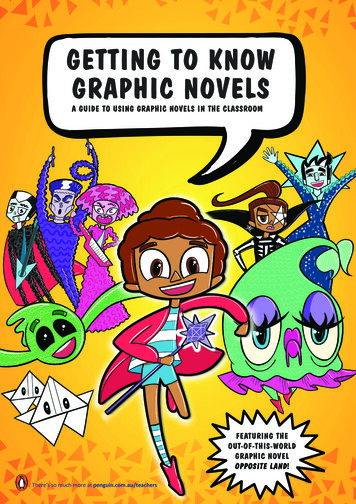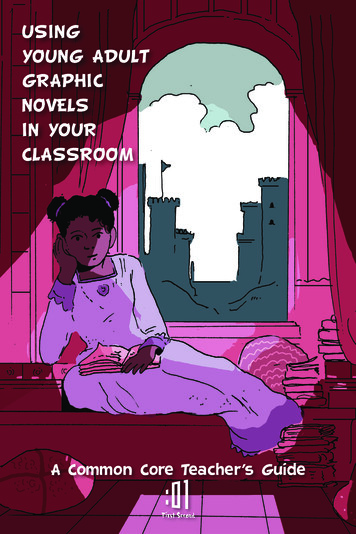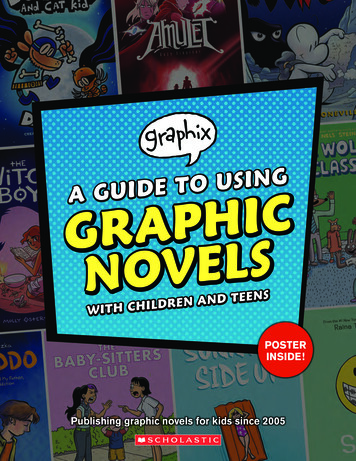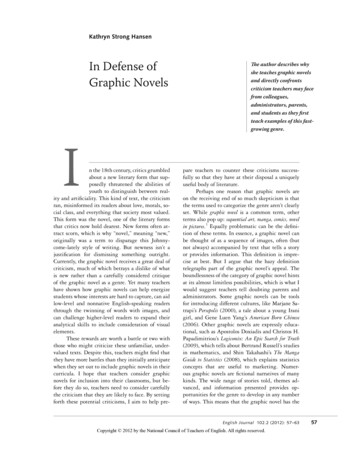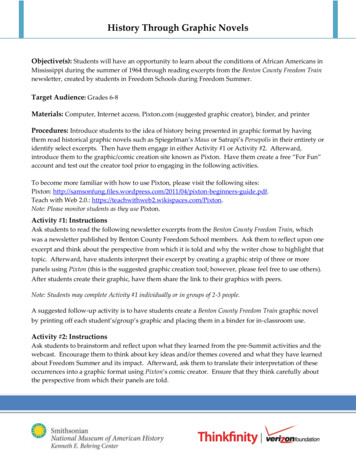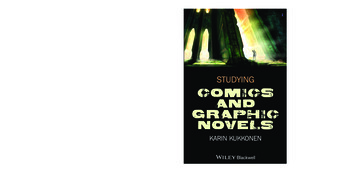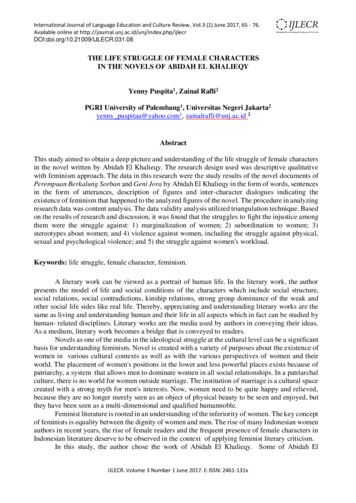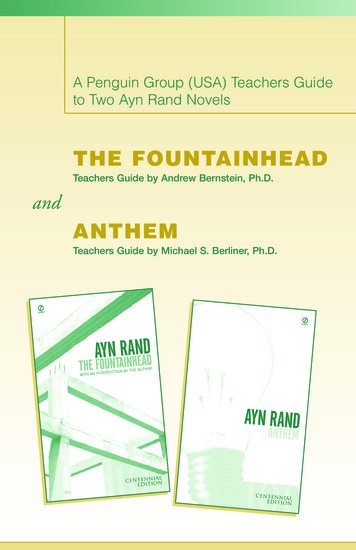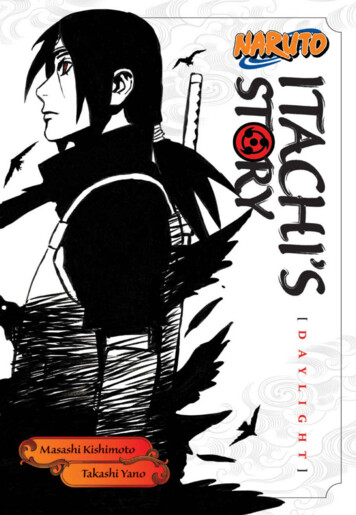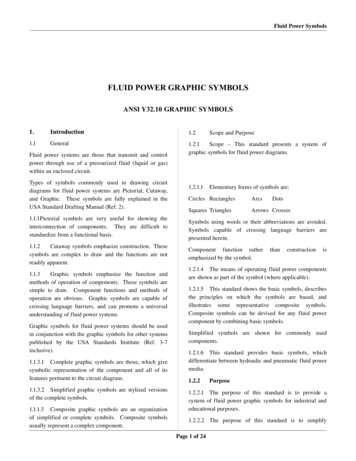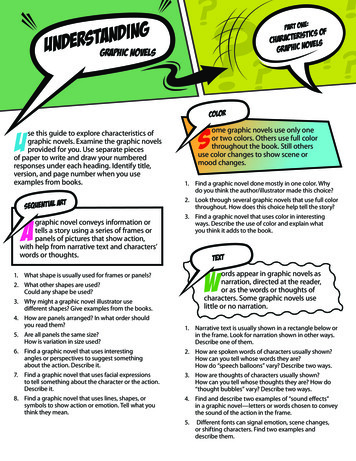
Transcription
gnidnatndersUPart one:tics ofsiretcarchaovelsgraphic nGraphic NovelsColorUse this guide to explore characteristics ofgraphic novels. Examine the graphic novelsprovided for you. Use separate piecesof paper to write and draw your numberedresponses under each heading. Identify title,version, and page number when you useexamples from books.tSequential ArAgraphic novel conveys information ortells a story using a series of frames orpanels of pictures that show action,with help from narrative text and characters’words or thoughts.1. What shape is usually used for frames or panels?2. What other shapes are used?Could any shape be used?3. Why might a graphic novel illustrator usedifferent shapes? Give examples from the books.4. How are panels arranged? In what order shouldyou read them?5. Are all panels the same size?How is variation in size used?6. Find a graphic novel that uses interestingangles or perspectives to suggest somethingabout the action. Describe it.7. Find a graphic novel that uses facial expressionsto tell something about the character or the action.Describe it.8. Find a graphic novel that uses lines, shapes, orsymbols to show action or emotion. Tell what youthink they mean.Some graphic novels use only oneor two colors. Others use full colorthroughout the book. Still othersuse color changes to show scene ormood changes.1. Find a graphic novel done mostly in one color. Whydo you think the author/illustrator made this choice?2. Look through several graphic novels that use full colorthroughout. How does this choice help tell the story?3. Find a graphic novel that uses color in interestingways. Describe the use of color and explain whatyou think it adds to the book.textWords appear in graphic novels asnarration, directed at the reader,or as the words or thoughts ofcharacters. Some graphic novels uselittle or no narration.1. Narrative text is usually shown in a rectangle below orin the frame. Look for narration shown in other ways.Describe one of them.2. How are spoken words of characters usually shown?How can you tell whose words they are?How do “speech balloons” vary? Describe two ways.3. How are thoughts of characters usually shown?How can you tell whose thoughts they are? How do“thought bubbles” vary? Describe two ways.4. Find and describe two examples of “sound effects”in a graphic novel—letters or words chosen to conveythe sound of the action in the frame.5. Different fonts can signal emotion, scene changes,or shifting characters. Find two examples anddescribe them.
{TeaPart one:istics ofcharacter velsographic ngnidnatUnderscheresotTeacher NGraphic NovelsNotes}1.Find a graphic novel done mostly in one color. Why doyou think the author/illustrator made this choice? (LunchLady or Babymouse series titles)2.Look through several graphic novels that use full colorthroughout. How does this choice help tell the story?3.Find a graphic novel that uses color in interesting ways.Describe the use of color and explain what you think itadds to the book. (Joey Fly uses color to signal settingchanges; The Storm in the Barn evokes Dust Bowl grimeand grimness with color)tSequential ArGood overall examples: There’s a Princess in thePalace, Atomic Ace (He’s Just My Dad), Joey Fly ,Legends of Zita the Space Girl, titles in the History’s KidHeroes series, Hereville, To Dance Agraphic novel conveys information or tells a storyusing a series of frames or panels of pictures thatshow action, with help from narrative text andcharacters’ words or thoughts.1.What shape is usually used for frames or panels? (Rectangles)2.What other shapes are used? Could any shape be used?(Many shapes! Probably any simple geometric shape)3.Why might a graphic novel illustrator use different shapes?Give examples from the books.4.How are panels arranged? In what order should you readthem? (Left to right, top to bottom, with variations; some Mangastyles read right to left)5.Are all panels the same size? How is variation in size used?6.TextGood overall examples: The Storm in the Barn;Atomic Ace (He’s Just My Dad); Into the Volcano;Legends of Zita the Space Girl; Joey Fly, Private Eye;Binky the Space CatWords appear in graphic novels as narration, directed atthe reader, or as the words or thoughts of characters.Some graphic novels use little or no narration.Find a graphic novel that uses interesting angles orperspectives to suggest something about the action.Describe it. (Legends of Zita the Space Girl, Hereville)1.Narrative text is usually shown in a rectangle below orin the frame. Look for narration shown in other ways.Describe one of them.7.Find a graphic novel that uses facial expressions to tellsomething about the character or the action. Describe it.(Joey Fly, Private Eye)2.How are spoken words of characters usually shown?How can you tell whose words they are? How do “speechballoons” vary? Describe two ways.8.Find a graphic novel that uses lines, shapes,or symbolsto show action or emotion. Tell what you think they mean.(Legends of Zita the Space Girl, Joey Fly )3.How are thoughts of characters usually shown? Howcan you tell whose thoughts they are? How do “thoughtbubbles” vary? Describe two ways.4.Find and describe two examples of “sound effects” in agraphic novel—letters or words chosen to convey thesound of the action in the frame.5.Different fonts can signal emotion, scene changes, orshifting characters. Find two examples and describethem.ColorGood overall examples: Joey Fly, Private Eye; TheStrongest Man in the World; The Storm in the Barn; ToDance ; The Meeting; Hereville; Gandhi: His Life Some graphic novels use only one or two colors. Othersuse full color throughout the book. Still others use colorchanges to show scene or mood changes.
Part TWO:gnidnatserUndLSPHIC NOVEARGGNIRCOMPAto proseGraphic NovelsChoose one prose book and one graphic novel that tellthe same story. Use separate pieces of paper to writeyour numbered responses under each heading. Identifytitle, version, and page number when giving specificexamples.LENGTH/USEOF PAGE SPACEGraphic novels generally convey informationor tell a story in a more compact way—fewerpages—than a traditional prose book1. How many pages does each book have? (Do a roughcount and estimate if pages are not numbered in yourgraphic novel.) Are the pages close to the same size?2. Choose a chapter or scene from your prose book.How many pages long is it? Identify the same content(chapter or scene) in your graphic novel. How long is it?3. If your prose book has illustrations, how much of thetotal page space do illustrations take up in the book? Inthe scene or chapter you compared?CharactersGraphic novels and prose use differentstrategies to introduce, describe, and helpreaders relate to characters.1. Read the first chapter or scene of your graphic novel,where you meet the main character. Make two columnson your paper. In the first column, describe the maincharacter as completely as you can. What does he or shelook like? How old is he or she? How does the characteract? What do you know about his or her personality? Lifeexperience? Relationships? Opinions?2. Read the same chapter or scene in your prose book. Inthe second column, describe the main character andanswer the same questions, using details from this book.3. Compare the two descriptions. How are they similar?How are they different? Which gives more detail? Whichlets you understand the character better?PlotGraphic novels and prose use differentstrategies to convey and move along theaction in the story.1. Choose a chapter or scene from the middle of thegraphic novel. Make two columns on your paper. Inthe first column, describe the action. What happens?What questions, tensions, or conflicts unfold? How docharacters relate to each other?2. Read the same chapter or scene in your prose book.In the second column, describe the action and answerthe same questions, using details from this book.3. Compare the descriptions. How are they similar? Howare they different? Which gives more detail? Whichmakes you feel the pace and follow the action better?eSetting & TonGraphic novels convey settings and tonedifferently. They describe and suggesthow places and people feel and influencethe action differently.1. Read the last chapter or scene of your graphic novel,in which conflict is resolved and the action broughtto a close. Make two columns on your paper. In thefirst column, describe the setting as completely as youcan. Where does the action take place? How does thesetting affect the action? Describe the emotional toneof the chapter. What feeling does it leave you with?2. Read the same chapter or scene in your prose book.In the second column, describe the setting and tone,and answer the same questions, using details fromthis book.3. Compare the descriptions. How are they similar? Howare they different? Which gives you a stronger sense ofplace? Which leaves you with a stronger sense of thebook’s emotional tone?ringCONCLUSION: Write a brief essay compaths of prosethe different strategies and strengand graphic novels. Include your thoughts aboutspecific stories, or kinds of stories, that might bestbe told in prose or as graphic novels.
{TeaPart TWO:RAPHICGGNIRAPCOMproseNOVELS tognidnatUnderscherotesTeacher NGraphic NovelsNotes}PlotTry this with prose and graphic novel versions of PercyJackson and the Olympians, or with Graphic Classics seriestitles and their prose originals for upper grades, or titlesin the History’s Kid Heroes series, from Graphic Universe, andtheir related early chapter books by the same authors, fromCarolrhoda Books, for younger students.Graphic novels and prose use different strategies toconvey and move along the action in the story.1.Choose a chapter or scene from the middle of thegraphic novel. Make two columns on your paper. Inthe first column, describe the action. What happens?What questions, tensions, or conflicts unfold? How docharacters relate to each other?2.Read the same chapter or scene in your prose book. Inthe second column, describe the action and answer thesame questions, using details from this book.3.Compare the descriptions. How are they similar? How arethey different? Which gives more detail? Which makesyou feel the pace and follow the action better?LENGTH/USEOF PAGE SPACEGraphic novels generally convey information or tella story in a more compact way—in fewer pages—than a traditional prose book.1.How many pages does each book have? (Do a roughcount and estimate if pages are not numbered in yourgraphic novel.) Are the pages close to the same size?2.Choose a chapter or scene from your prose book.How many pages long is it? Identify the same content(chapter or scene) in your graphic novel. How long is it?3.If your prose book has illustrations, how much of thetotal page space do illustrations take up in the book?What about in the scene or chapter you compared?CharactersESETTING & TONGraphic novels convey settings and tone differently.They describe and suggest how places and peoplefeel and influence the action differently.1.Read the last chapter or scene of your graphic novel,in which conflict is resolved and the action brought toa close. Make two columns on your paper. In the firstcolumn, describe the setting as completely as you can.Where does the action take place? How does the settingaffect the action? Describe the emotional tone of thechapter. What feeling does it leave you with?2.Read the same chapter or scene in your prose book. Inthe second column, describe the setting and tone, andanswer the same questions, using details from this book.3.Compare the descriptions. How are they similar? Howare they different? Which gives you a stronger sense ofplace? Which leaves you with a stronger sense of thebook’s emotional tone?Graphic novels and prose use different strategiesto introduce, describe, and help readers relateto characters.1.2.3.Read the first chapter or scene of your graphic novel,where you meet the main character. Make two columnson your paper. In the first column, describe the maincharacter as completely as you can. What does heor she look like? How old is he or she? How does thecharacter act? What do you know about his or herpersonality? Life experience? Relationships? Opinions?Read the same chapter or scene in your prose book. Inthe second column, describe the main character andanswer the same questions, using details from this book.Compare the two descriptions. How are they similar?How are they different? Which gives more detail?Which lets you understand the character better?the differentCONCLUSION: Write a brief essay comparingnovels.strategies and strengths of prose and graphicInclude your thoughts about specific stories, or kinds ofstories, that might best be told in prose or as graphic novels.
Season SlipsName:SPRINGI read about spring because:Name:SUMMERI read about summer because:Title and author of spring book:Title and author of summer book:Here is one thing I learned about thespring season:Here is one thing I learned about thesummer season:Name:FALLI read about fall because:Name:WINTERI read about winter because:Title and author of fall book:Title and author of winter book:Here is one thing I learned about thefall season:Here is one thing I learned about thewinter season:
7. Find a graphic novel that uses facial expressions to tell something about the character or the action. Describe it. (Joey Fly, Private Eye) 8. Find a graphic novel that uses lines, shapes, or symbols to show action or emotion. Tell what you think they mean. (Legends of Zita the Space Girl, Joey Fly ) S ome graphic novels use only one or .
